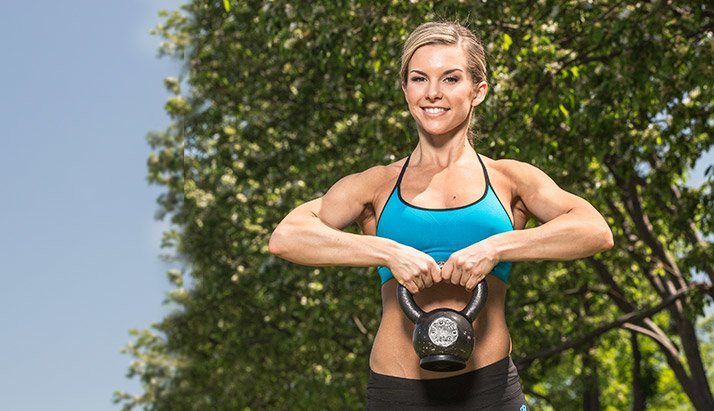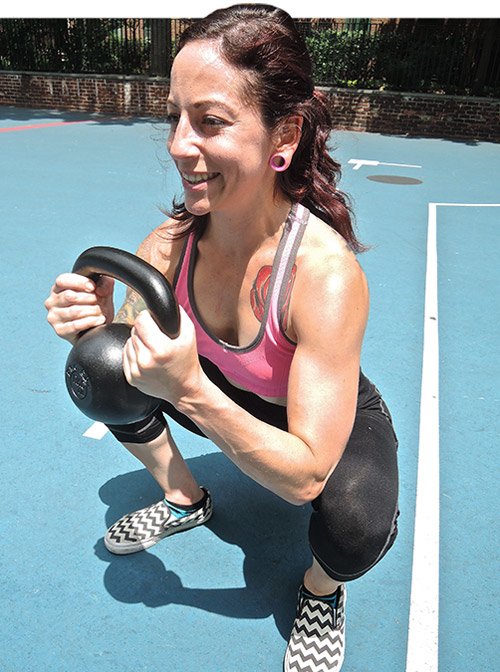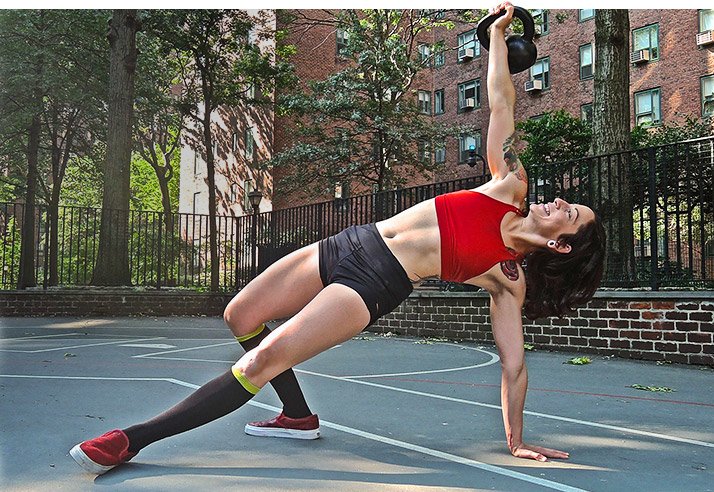
Elevate Your Yoga Practice With Strength Training
Take your practice to new heights with this simple twice-weekly routine. Then be prepared for everyone to ask what your secret is!
Yoga by itself can be considered a complete practice, if you approach it right. In just 60-90 minutes a couple of times a week, it can deliver strength, flexibility, a good sweat, and stress management all at the same time—which is to say nothing of the pure fun and challenge of doing it. It's even considered a sport these days, where advanced yoga athletes can show off their skills in competition.
However, let's be honest: The average yoga practitioner doesn't train like a yoga athlete. Unless you are going three or more times a week and attending progressively more advanced classes, it can be easy for your practice to become stagnant. You may not even realize it's happening. But if you're consistently unable to nail your goal poses or you find yourself hitting the same ceilings in your practice over and over again, the answer is probably not to do more of what you've been doing.
You have weaknesses that need to be addressed! And some strategic strength training can do just that. In my article "Get Yoga Strong," I explained how the two can go together in a single session. But you could also pursue them separately by adding 1-2 sessions of kettlebell training to your weekly routine.
Yes, to be clear, yoga can make you strong. But yoga and strength training together can make you stronger—both in your practice and in your life. Here's how.
Why the Kettlebell?
At first, going from the peaceful confines of a toasty yoga class to the testosterone-fueled atmosphere of the gym can be a scary transition. Just the thought of lifting heavy metal off the ground used to make me nervous. After I confronted my fears, however, I realized it was the missing piece of my training regimen. It felt immediately empowering!
Right away, I found—thankfully—that my experience with yoga was advantageous in a number of ways. First and foremost, it gave me experience with training regularly. The deeper I've gotten into strength training, both with kettlebells and with bodyweight movements like the handstand push-up and pull-up, the more I've seen how consistency really is what makes progress happen.

However, the kettlebell also seemed to offer some specific benefits. After I began training with them, I finally started to lean out and add some muscle. After teaching my regular yoga class, my students would often approach me to ask about my improved physique and inquire about strength training with me instead. That's when I knew I was onto something.
Not surprisingly, some of my best clients have also been those with a yoga background. Yogis tend to have a strong mind-body connection and muscular control, which are invaluable skills as an athlete. Their mobility and flexibility also tends to be better than the average client.
Kettlebell training allows you to put the benefits of yoga to the test, and expend a lot of pent-up energy while you do it. As an added plus, you don't necessarily have to go to the gym at all—you can just buy a couple of weights and stash them in the closet when you're not using them.
Let's explore three classic kettlebell lifts and see how they can improve your practice.
The Goblet Squat
Malasana is a yoga pose in which you essentially hold the bottom position of a squat. When teaching this move in class, I would see many yogis struggling. Either they weren't squatting deep enough, or they were unable to keep their heels flat on the ground.

As we grow older, our ability to squat properly diminishes even further if we don't maintain it. Practicing goblet squats, a move popularized by strength coach Dan John, can help you hone this essential movement pattern.
Loading a squat again can seem intimidating if you're new to weight training, but in this case, you'll be happy to know it actually makes the move easier. Loading the front of the body with weight helps you balance at the bottom position of the squat.
Sure, you can do it with a weight plate or dumbbell, but holding the kettlebell allows you to use your elbows to push the knees out, allowing you to own the bottom position more easily. It's often the first kettlebell lift taught to beginners, because it doesn't require much weight and can quickly teach almost anyone to squat properly.
To do a goblet squat:
- Stand with feet around hip-width apart with your feet slightly turned out. Grab onto the horns of the bell, with elbows tucked firmly at the sides of your body.
- Inhale into your abdomen as you descend, stopping right when your elbows touch the inside of your thighs.
- Exhale as you return to standing position, fully extending your hips forward and locking your knees. Focus on keeping your back straight and heels down during the entire movement.
As a warm-up or mobility drill, you'll want to practice it at a moderately slow pace, pausing at the bottom position for anywhere from 3-5 seconds. The time under tension will help you boost mobility and squat deeper. If you're performing it for reps like in the program below, only a slight pause is necessary.
The Kettlebell Swing
In yoga, most postures are practiced unilaterally in order to prevent imbalances between the right, left, front, and back sides of the body. Poses like the forward fold and the backbend are beneficial for stretching the anterior and posterior chains of the body.
However, in terms of strengthening the front and back of the body, nothing tops the kettlebell swing! The swing works all the muscles of the lower half of the body, as well as the abs, shoulders, and even back.
The Kettlebell Swing
Watch the video - 00:24
Swinging for reps can also have an awesome cardiovascular effect on the body, elevating your heart rate every bit as much as running or swimming laps.
To do a kettlebell swing:
-
Stand with your feet about hip-width apart, with the kettlebell centered in front of your feet. Place your hands on your hips and push your hips back, creating the hinging position. This drill is helpful for "loading the hips" which will allow you to transfer weight from the front to the back of the body and thus activate all the muscles in your posterior chain. The position is similar to the downward-facing dog position with your body bent in half.
-
Bend your knees just enough for you to reach for the bell, but avoid squatting too deep. Remember, a hip hinge like this is not a squat. Keep your back straight and your chest lifted as you grab the handle and tilt the bell back toward you. Hold this position for a second.
-
Squeeze the handle and hike the bell back through your legs. Exhale forcefully through your mouth as you stand, extending your hips and knees powerfully at the top to initiate a "float" from the bell. Repeat for repetitions.
It's crucial to remember that the swing is initiated from the hips and glutes, not the arms. Your arms are there to guide the bell into the bottom and top positions so keep them slightly relaxed during the movement.
If you are doing it correctly, the bell should feel weightless for a moment before you actively pull back through your legs. Try not to swing the bell lower than your knees to avoid rounding your back, or higher than shoulder height.
Turkish Get-Up
If you enjoy the flow of yoga's sun salutation, then you'll love the Turkish get-up! It's graceful sequence combines strength, balance, and coordination. It can give you a lot of bang for your buck, just like a properly executed sun salutation.
Turkish Get-up
Watch the video - 00:44
Just as developing intense focus and presence is a constant theme in yoga, the get-up requires you to carefully manipulate your body through multiple planes of motion around the kettlebell. If you're not focused while performing the get-up, that bell can come tumbling down!
To do a Turkish get-up:
-
Start by lying on your back with your right arm extended overhead, holding the kettlebell firmly. Make sure your elbow is locked—not flexed!
-
Bend your right knee in toward your butt. Your left leg and arm should be extended flat on the floor at around 45 degrees.
-
Keeping your right arm locked overhead, shift your weight onto your left forearm. Next, press up onto your left palm and your right foot as you extend your hips up into a straight bridge position.
-
Now bring your extended left leg behind you into a lunge. Keep your eye on the kettlebell and come to a full standing position. Carefully reverse the movement and repeat on your left side.
Yes, it can seem complicated at first. If you're a beginner, practice the sequence first without weight until you memorize the transitions. Then try it with 10-15 pounds before working your way to heavier loads. In time, you'll be surprised by how much weight you can move!

Turkish Get-Up
One of the benefits of practicing the get-up regularly is that it develops strength that carries over to exciting poses in yoga like arm balances. The get-up can increase strength in your shoulders, particularly in the stabilizer muscles, which can help you hold poses like the crow or flying pigeon with confidence.
During the sequence, you also heavily recruit your abs, legs, and even your back muscles, making it an awesome total-body exercise!

